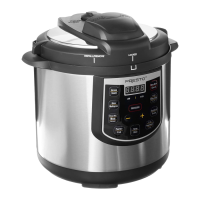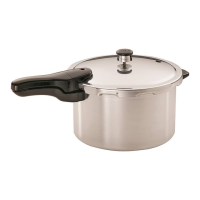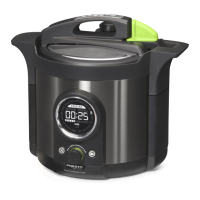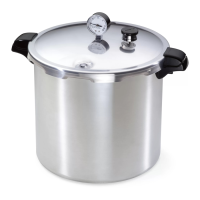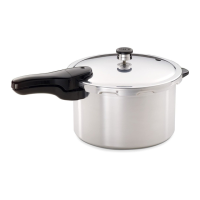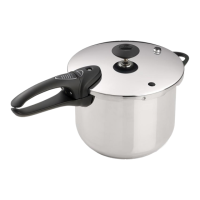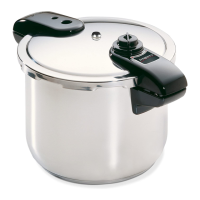6
HOW TO PRESSURE CAN FOODS
IMPORTANT: Do not attempt to use your canner before carefully reading these instructions.
Follow these step-by-step instructions for pressure canning in your canner. Prepare food according to the processing procedures in
specic recipe.
1. Be sure your canner is thoroughly cleaned and working properly. Before each canning season, have the dial gauge checked for
accuracy (see page 8). Also check the sealing ring, overpressure plug, and the small white gasket of the air vent/cover lock. Replace
these parts when they become hard, deformed, cracked, worn, pitted, or unusually soft.
2. If canning on an electric smooth-top or induction range, refer to instructions for canning in the owner’s manual for your range. Always
clean the stovetop with a cooktop polishing cream, according to the range manufacturer’s instructions, before and after canner use.
In addition, to avoid scratching the ceramic glass surface of the smooth-top or induction range, check the bottom of the canner to be
sure it is clean and free of debris and does not have any nicks or scratches.
3. Check Mason jars for nicks, cracks, and sharp edges. Check screw bands for dents or rust. Use only
jars, lids, and screw bands in perfect condition so an airtight seal may be obtained.
Wash and rinse jars, lids, and screw bands. Pour hot water into jars and set aside until needed. Follow
closure manufacturer’s directions for preparing lids.
4. Select fresh, rm food. Sort food according to size. Clean food thoroughly. Prepare according to specic
recipe. Fill hot jars promptly with food and liquid to recommended level. Allow ½-inch headspace
for fruits. Most vegetables and meats require 1-inch headspace due to expansion during processing.
Work out air bubbles with a clean nonmetallic spatula. Wipe sealing edge clean with a damp cloth.
Adjust screw bands according to closure manufacturer’s directions.
5. Place 3 quarts of hot water (for hot packed foods the water can be heated to 180°F, which is not quite
boiling) and canning rack in canner (Fig. D). To prevent water stains on jars, add 2 tablespoons white
vinegar to water in canner. Always use canning rack as jars may break if set directly on bottom of
canner. NOTE: 3 quarts of water are needed regardless of how many jars are being canned.
6. Place lled jars on canning rack immediately after each jar is lled.
7. Hold the cover up to the light and look through the vent pipe (Fig. E) to be certain it is clear before
placing the cover on the canner. If it is clear, proceed to step 8. If it is blocked, clean the vent pipe
and vent pipe nut with a small brush or pipe cleaner (Fig. F and Fig. G).
8. Check to be sure the overpressure plug is seated properly in the cover (see page 8, Fig. M).
9. Place cover on canner, aligning the V mark on the cover with the inverted V mark on the body han-
dle (Fig. H). Press down on the cover handles to compress the sealing ring and turn the cover in the
direction indicated to close (clockwise) until the cover handles are above the body handles. Do not
rotate the cover beyond this point.
10. Position canner on a level burner and range only. Use on a tilted burner or range may interfere with
the operation of the pressure regulator. For electric coil, smooth-top, and induction ranges, use the
element that most closely matches the 9-inch diameter of the canner bottom. This is the portion of
the canner bottom which comes in contact with the element.
CAUTION! Do not use on any outdoor LP gas burner or a gas range over 12,000 BTU’s. Using too
large of an element or over 12,000 BTU’s may soften the canner causing the bottom to warp. It may
also result in property damage and/or personal injury.
Using a relatively high setting, heat the pressure canner until a steady ow of steam can be seen,
heard, or felt coming from the vent pipe (Fig. I). Exhaust air from the canner for 10 minutes by al-
lowing steam to ow from the vent pipe. Reduce heat, if necessary, to maintain a steady, moderate
ow of steam.
11. Place pressure regulator on vent pipe. If heat was reduced for exhausting, adjust to a relatively high
setting and heat canner. As pressure develops in the canner, the air vent/cover lock will lift and lock
the cover on the canner. The air vent/cover lock is a visual indicator of the presence of pressure. When
in the up position, pressure is in the canner; when in the down position, there is no pressure in the
canner (Fig. J, page 7). Also, as pressure builds, the pointer of the gauge will move across the face.
Continue heating until the pressure dial gauge registers the correct pressure. Adjust heat to maintain
the correct pressure on the dial gauge. The pressure regulator will rock ONLY at 15 pounds of pressure.
READ INSTRUCTIONS
BEFORE OPERATING
psi
0
5
10
15
20
Fig. D
3-quart Water Line (lowest
mark in canner)
Fig. E
Fig. F
Fig. G
Align the V mark on the cover with the
inverted V mark on the body handle.
Fig. H
Fig. I
